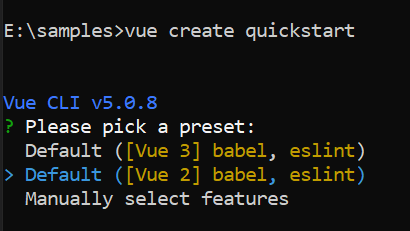Getting Started with the Vue Accumulation chart Component in Vue 2
25 Apr 20255 minutes to read
This article provides a step-by-step guide for setting up a Vue 2 project using Vue-CLI and integrating the Syncfusion® Vue Accumulation chart component
Prerequisites
System requirements for Syncfusion® Vue UI components
Dependencies
The list of minimum dependencies required to use an accumulation chart are follows:
|-- @syncfusion/ej2-vue-charts
|-- @syncfusion/ej2-base
|-- @syncfusion/ej2-data
|-- @syncfusion/ej2-pdf-export
|-- @syncfusion/ej2-file-utils
|-- @syncfusion/ej2-compression
|-- @syncfusion/ej2-charts
|-- @syncfusion/ej2-vue-base
|-- @syncfusion/ej2-svg-baseSetting up the Vue 2 project
To generate a Vue 2 project using Vue-CLI, use the vue create command. Follow these steps to install Vue CLI and create a new project:
npm install -g @vue/cli
vue create quickstart
cd quickstart
npm run serveor
yarn global add @vue/cli
vue create quickstart
cd quickstart
yarn run serveWhen creating a new project, choose the option Default ([Vue 2] babel, eslint) from the menu.

Once the quickstart project is set up with default settings, proceed to add Syncfusion® components to the project.
Add Syncfusion® Vue packages
Syncfusion® packages are available at npmjs.com. To use Vue components, install the required npm package.
This article uses the Vue Accumulation chart component as an example. Install the @syncfusion/ej2-vue-charts package by running the following command:
npm install @syncfusion/ej2-vue-charts --saveor
yarn add @syncfusion/ej2-vue-chartsThe –save will instruct NPM to include the chart package inside of the
dependenciessection of thepackage.json.
Add Syncfusion® Vue component
Follow the below steps to add the Vue Accumulation chart component using Composition API or Options API:
1. First, import and register the Accumulation chart component in the script section of the src/App.vue file.
<script>
import { AccumulationChartComponent, AccumulationSeriesCollectionDirective, AccumulationSeriesDirective, PieSeries } from "@syncfusion/ej2-vue-charts";
export default {
components: {
'ejs-accumulationchart': AccumulationChartComponent,
'e-accumulation-series-collection': AccumulationSeriesCollectionDirective,
'e-accumulation-series': AccumulationSeriesDirective
}
}
</script>2. In the template section, define the Accumulation chart component with the dataSource property.
<template>
<div id="app">
<ejs-accumulationchart id="container">
<e-accumulation-series-collection>
<e-accumulation-series :dataSource='seriesData' xName='x' yName='y'> </e-accumulation-series>
</e-accumulation-series-collection>
</ejs-accumulationchart>
</div>
</template>3. Declare the value for the dataSource property in the script section.
<script>
data() {
return {
seriesData: data
};
}
</script>Adding Chart Component
- Add the Vue Chart by using
<ejs-chart>selector in<template>section of theApp.vuefile.
The below example shows a basic Charts,
- Pie Series
By default pie series will be rendered on assigning JSON data to the series by using dataSource property. Map the field names in the JSON data to the xName and yName properties of the series.
<template>
<div id="app">
<ejs-accumulationchart id="container">
<e-accumulation-series-collection>
<e-accumulation-series :dataSource='seriesData' xName='x' yName='y'> </e-accumulation-series>
</e-accumulation-series-collection>
</ejs-accumulationchart>
</div>
</template>
<script>
import { AccumulationChartComponent, AccumulationSeriesCollectionDirective, AccumulationSeriesDirective, PieSeries } from "@syncfusion/ej2-vue-charts";
import { data } from "./data.ts";
export default {
name: "App",
components: {
'ejs-accumulationchart': AccumulationChartComponent,
'e-accumulation-series-collection': AccumulationSeriesCollectionDirective,
'e-accumulation-series': AccumulationSeriesDirective
},
data() {
return {
seriesData: data
};
},
provide: {
accumulationchart: [PieSeries]
}
};
</script>
<style>
#container {
height: 350px;
}
</style>Run the project
To run the project, use the following command:
npm run serveor
yarn run serve